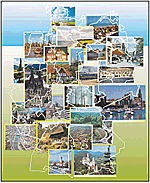Topic 1: Physical Geography of Germany

Lesson 3: What are some unique characteristics of the German states?
Lesson Objective
The student will identify characteristics of the German Länder and determine which is most similar to their home state.
Materials and Resources
 Transparency 9 - "States of the Federal Republic of Germany” |  Transparency 10 - “The Federal States” |
- Teacher Resource 2 - “Comparative Areas and Populations”
- Handout 3 - “The Federal States”
- Teacher Resource 3 - “Key: The Federal States”
- Worksheet 2 - “Researching a German State”
Background Information
On May 23, 1949, the states of Baden-Württemberg, Bavaria, Bremen, Hamburg, Hesse, Lower Saxony, North Rhine-Westphalia, Rhineland-Palatinate, and Schleswig-Holstein (which had been occupied by the Western Allies after World War II) united to become the Federal Republic of Germany. To this union was added West Berlin, which was given a special status since it was not actually a part of the Federal Republic of Germany, but in practice was treated as if it were. The Saarland, which had been under French administration since 1945, joined after a vote on January 1, 1957.
Soon after the founding of the Federal Republic of Germany, on October 7, 1949, Soviet-occupied Germany became the German Democratic Republic (East Germany). The German Democratic Republic was also divided into states: Mecklenburg, Brandenburg, Saxony-Anhalt, Thuringia and Saxony. These states existed until 1952, when they were dissolved into smaller administrative districts.
Already in 1946/47 disagreements between the four victorious powers, the United States, the United Kingdom, the Soviet Union and France, dominated post-war decisions, among them the future of the occupied German territory. The effect of the disagreements between the four powers led to what we know as the Cold War. This conflict between the three Western powers and the Soviet Union eventually led to the division of Germany into two states and decided the different political and economic systems both countries would follow in the coming forty years.
The German territories of the former German Reich that were east of the rivers Oder and Neisse were placed under Polish and Soviet administration and became part of Poland and the Soviet Union. In the last months of the war and in the following years 12 million Germans fled from the then eastern provinces of Germany (now Poland) and from Czechoslovakia or were expelled from there. They had to be integrated into the Federal Republic of Germany and into the German Democratic Republic.
The division of Germany into the Federal Republic of Germany and the German Democratic Republic lasted until October 3, 1990. On this day the German Democratic Republic ceased to exist as a separate country, having again been divided into the states of Brandenburg, Mecklenburg-Western Pomerania, Saxony-Anhalt, Saxony and Thuringia, which then joined the Federal Republic of Germany. After 40 years of being divided, Germany has again become a unified country, and the capital of the Federal Republic of Germany is officially Berlin.
The Federal Republic of Germany has a federal structure, meaning that each federal state and the three city-states (Bremen, Hamburg, Berlin) have a great deal of independence and individuality.
The Federal Republic of Germany has a land area of about 138,000 square miles and a population of 82.5 million people. In comparison to other countries of the world Germany is relatively small geographically and densely populated.
The size of the population differs among the different federal states. The population density in the citystates of Berlin, Bremen and Hamburg is particularly high. The states which have many industrial areas also have very densely settled regions.
Strategies
Place Transparencies 4 and 5A on the overhead. Have students identify the countries bordering Germany (there are nine). Then, have students identify the “Länder” (states) of the Federal Republic. Identify the capital city of each Land. Explain that Bremen, Hamburg and Berlin, by way of history, are not just cities but also federal states.
Explain that the capital cities of the Länder are not necessarily the most important or largest ones (e.g. Frankfurt in Hesse and Cologne in North Rhine-Westphalia are much larger and more popular than Wiesbaden or Düsseldorf).
Give students information on population density in the United States and in Europe using a familiar point of reference (e.g. your state). Teacher Resource 2 “Comparative Areas and Populations” provides information about each of the federal states compared to the total German nation, Europe and the United States.
Have students individually write a paragraph describing their state (e.g., relative location, physical characteristics, capital and major cities, economic base and major attractions). Place students into pairs and have them compare their own state descriptions with the various German Federal States depicted in Handout 3 “The Federal States” and Transparency 9, “The States of the Federal Republic of Germany” and Transparency 10, “The Federal States”. Ask each pair to select a German state which is most similar to their own state. Randomly call on several pairs of students to solicit their reasoning for selecting a particular German state. After each group has reported, the class should reach consensus about which German state most resembles their own state.
As an enrichment activity, students may be encouraged to complete an in-depth research focusing on one of the German states: Place students in groups of four, ask each group to choose a different German state to research, and then provide each group with Worksheet 2 “Researching a German State” for their report which outlines elements of the project.

 Printable PDF
Printable PDF